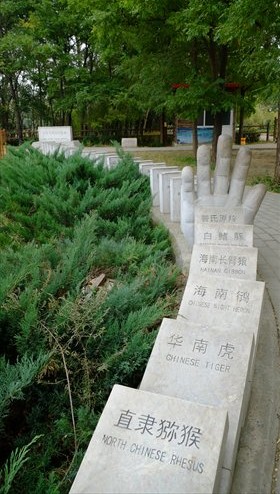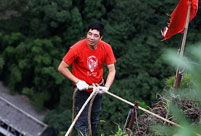 |
| This public sculpture is intended as a wake-up call about looming ecological disaster. Photo: Yin Lu/G |
As you stroll through a nature reserve, enjoying fresh air, birdsong and a glimpse of deer, you're probably not expecting to stumble upon a tombstone, let alone a hundred of them, toppling onto each other like a line of dominoes.
Across a large square these headstones sprawl, each one engraved with the name of an animal species in both Chinese and English, as well as extinction dates provided by the International Union for Conservation of Nature.
This piece of public sculpture, known as the World Extinct Wildlife Cemetery, is located at the Beijing David's Deer Park Museum in Daxing district, and intended as a wake-up call for visitors.
An engraved tablet explains it all: "Ever since the Industrial Revolution, humans have expanded infinitely and do as they want in the name of civilization, causing hundreds of animal species to disappear."
"The inspiration of this design came from the fact that the extinction of one species causes the extinction of dozens of others, because they are all closely linked together," said Guo Geng, the cemetery's designer and vice director of the museum's ecological research center. "For example, the extinction of bees would lead to a collapse of plants. It's like a chain reaction, extinctions one after another, so I compare it to the domino effect," Guo said.
Near the end of the line stands a big hand interrupting the cascade, which symbolizes humans taking action to protect the endangered species and to prevent their extinction.
There are three kinds of gravestones: those that have fallen down, representing the extinct animals; those on the verge of collapse, representing species in imminent danger of extinction; and those standing behind the giant hand, representing extant species.
The Yangtze River Dolphin is one species whose destiny hangs by a thread. Guo told Metropolitan that the Yangtze River Dolphin was last seen in the 1990s.
"We are now in the Sixth Extinction," said Guo. "Species dying out has been a natural occurrence during the 3.8 billion years since the first lifeform came to exist. But natural extinction takes a long time. In a few hundred years, human civilization has caused the extinction of thousands of species," Guo explained.
"This is happening at a horrifying rate, and species will keep falling like dominoes until the headstone of human beings falls." The gravestone of humans (Homo sapiens) is not the final one; behind it is the gravestone of mice.
For thousands of years, this very site was a paradise for a type of ruminant called Père David's Deer, but the animal became extinct in the wild due to hunting and war. Luckily, a few had been imported to Europe and survived. In 1985, 22 deer were brought back to the park, which has become a place to celebrate the potential for humans to protect animal species. "This represents the awakening of people - that the giant hand is working," said Guo.
The cemetery was completed on April 22, 1999, World Earth Day. "The date implies the Earth belongs not only to humans, but also the other species. We are only one citizen of the Earth," said Guo. Most visitors to the cemetery are students from elementary and middle schools; the site is especially popular during summer vacations, the Tomb Sweeping Festival, and World Animal Day (October 4).
Wang Yue, 18, a senior at a Fangshan district high school, recently paid her respects at the cemetery. "Humans should examine themselves, and protect the environment. I feel very insecure after seeing this. Luckily, we have the giant hand protecting us," she said.
 2013 Colour Me Rad 5K run held in Canada
2013 Colour Me Rad 5K run held in Canada China's destroyer Qingdao sails out of Sydney Harbor
China's destroyer Qingdao sails out of Sydney Harbor Chinese tycoon aims to restore London's Crystal Palace
Chinese tycoon aims to restore London's Crystal Palace Worst flooding hits Yuyao, 70% of downtown area underwater
Worst flooding hits Yuyao, 70% of downtown area underwater Game for the brave: 'Spiders' in Yandang Mountains
Game for the brave: 'Spiders' in Yandang Mountains Hungarian wingsuit flyer confirmed dead in Zhangjiajie
Hungarian wingsuit flyer confirmed dead in Zhangjiajie New couples take wedding photos during holiday
New couples take wedding photos during holiday Serena Williams stumbles through to quarterfinals
Serena Williams stumbles through to quarterfinals Thailand Mobile Expo 2013 kicks off
Thailand Mobile Expo 2013 kicks off Photo collection of Chinese Navy
Photo collection of Chinese Navy Photo story: Young tenants in Beijing
Photo story: Young tenants in Beijing Twins Culture Festival kicks off in Beijing
Twins Culture Festival kicks off in Beijing UNESCO world heritage site: Montale Tower
UNESCO world heritage site: Montale Tower Israeli drone crashes into Mediterranean, fragments recovered
Israeli drone crashes into Mediterranean, fragments recovered Serena Williams wins second China Open title
Serena Williams wins second China Open titleDay|Week|Month